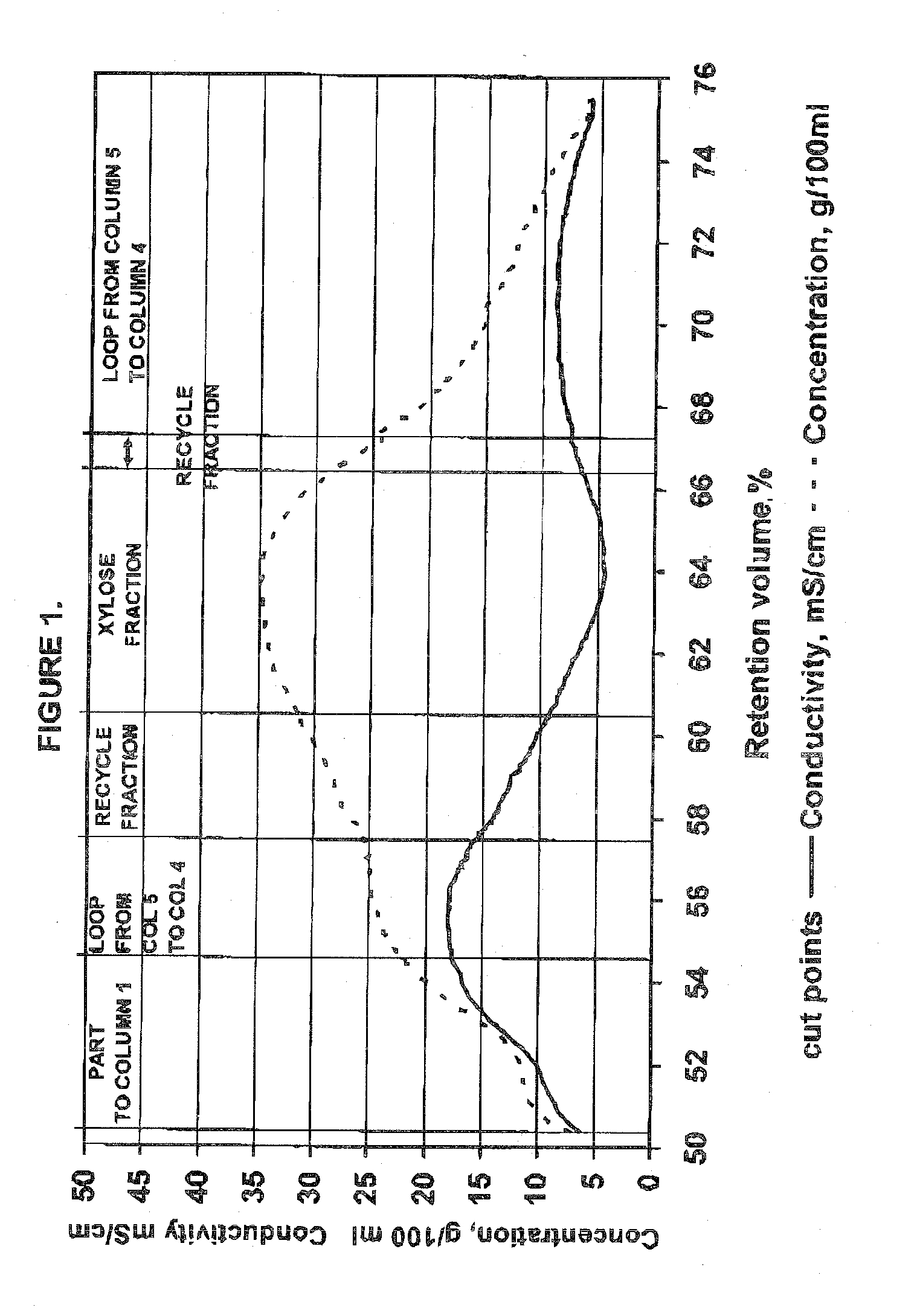Separation process
a separation process and chromatographic technology, applied in the field of chromatographic separation, can solve the problem of the high ratio of eluent to feed, and achieve the effect of reducing the volume of fresh eluent and reducing the energy requiremen
- Summary
- Abstract
- Description
- Claims
- Application Information
AI Technical Summary
Benefits of technology
Problems solved by technology
Method used
Image
Examples
example 1
Chromatographic SMB Separation of MySSL®—Reference Example
[0137]The process equipment included five columns connected in series, a feed pump, recycling pumps, an eluent water pump, heat exchangers, flow control means for out-coming liquids as well as inlet and product valves for the various process streams. The height of first three columns was 3.6 m and the height of last two columns was 4.6 m, and each column had a diameter of 4.2 m. The columns were packed with a strong acid gel type cation exchange resin (manufactured by Finex) in Mg2+ form. The divinylbenzene content of the resin was 6.5%, and the mean bead size of the resin was 0.38 mm.
[0138]Before the separation, Mg2+ sulfite spent liquor (MgSSL) was diluted with a recycle fraction to 52 weight-% and pre-coat filtered using Arbocel B800 as a filter aid. The feed dry substance was further adjusted with a recycle fraction to 48.1 g / 100 g and the feed liquor pH was 3.4. The feed was composed as set forth below, whereby the perce...
example 2
Chromatographic SMB Separation of MgSSL
[0151]The process equipment included five columns connected in series, a feed pump, recycling pumps, an eluent water pump, heat exchangers, flow control means for out-coming liquids as well as inlet and product valves for the various process streams. The height of first three columns (a volume of 49.9 m3 each) was 3.6 m and the height of last two columns (a volume of 63.7 m3 each) was 4.6 m, and each column had a diameter of 4.2 m. The columns were packed with a strong acid gel type cation exchange resin (manufactured by Finex) in Mg2+ form. The divinylbenzene content of the resin was 6.5%, and the mean bead size of the resin was 0.38 mm.
[0152]Before the separation. Mg2+ sulfite spent liquor was diluted with a recycle fraction to 52 weight-% and pre-coat filtered using Arbocel B800 as a filter aid. The feed dry substance was further adjusted with a recycle fraction to 48.2 g / 100 g, and the feed liquor pH was 3.22. The feed was composed as set f...
example 3
Chromatographic SMB Separation of MgSSL—Pilot Test
[0167]The process equipment included five columns connected in series, a feed pump, recycling pumps, an eluent water pump, heat exchangers, flow control means for out-coming liquids as well as inlet and product valves for the various process streams. The equipment also included a tank, a feed pump, lines, flow control means and valves for the collection and feeding of a fraction to be used as an eluent water replacement. The height of first three columns (a volume of 282 liters each) was 3.6 m, and the height of last two columns (a volume of 36.1 liters each) was 4.6 m, and each column had a diameter of 0.11 m. The void volumes of the resins in the columns were: 11.5 liters for column 1, 10.9 liters for column 2, 11.3 liters for column 3, 15.8 liters for column 4, and 15.1 liters for column 5. The columns were packed with a strong acid gel type cation exchange resin (manufactured by Rinex) in Mg2+ form. The divinylbenzene content of ...
PUM
| Property | Measurement | Unit |
|---|---|---|
| crosslinking degree | aaaaa | aaaaa |
| particle size | aaaaa | aaaaa |
| diameter | aaaaa | aaaaa |
Abstract
Description
Claims
Application Information
 Login to View More
Login to View More - R&D
- Intellectual Property
- Life Sciences
- Materials
- Tech Scout
- Unparalleled Data Quality
- Higher Quality Content
- 60% Fewer Hallucinations
Browse by: Latest US Patents, China's latest patents, Technical Efficacy Thesaurus, Application Domain, Technology Topic, Popular Technical Reports.
© 2025 PatSnap. All rights reserved.Legal|Privacy policy|Modern Slavery Act Transparency Statement|Sitemap|About US| Contact US: help@patsnap.com

